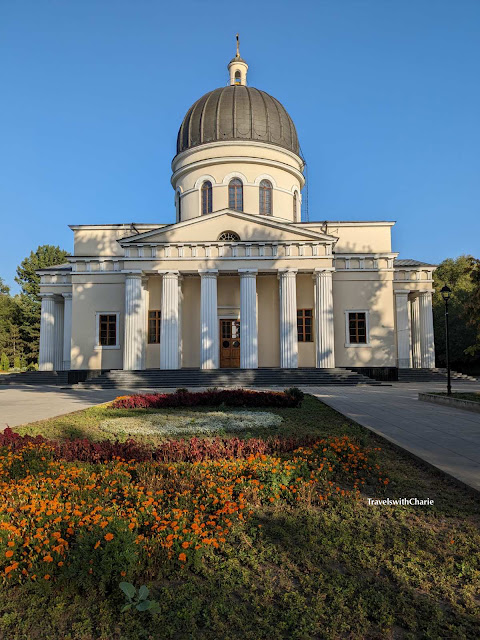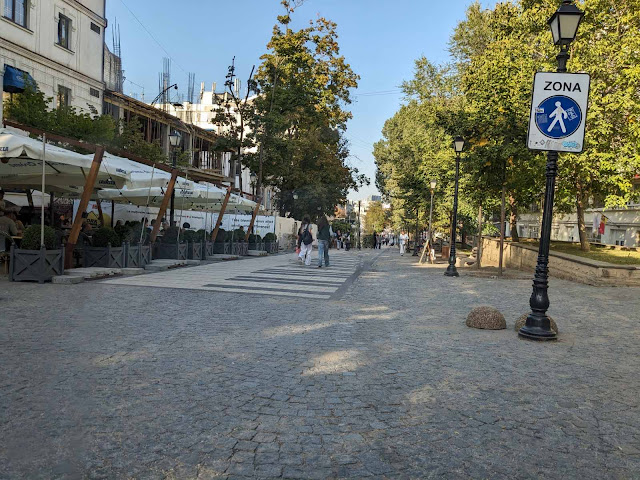Cathedral Park
Moldova is one of the least visited countries in the world according to the United Nations World Tourism Organization. It received 174,000 visitors in 2019 and the pandemic effectively slashed the number of visitors to 29,000 in 2020. It’s too bad because Moldova has a lot to offer, especially to wine enthusiasts. But it won’t be long before Moldova will be “rediscovered” by intrepid travelers and then we will whine about how crowded it is. Already the traffic in Chișinău is a growing pain for the country. Thankfully, there are many beautiful parks in the city when you need a break and a cup of coffee.
Cathedral of Christ’s Nativity
The Nativity Cathedral was built in the 1830s in the Neoclassical style after the design of Adam Melnikov, its chief architect. It lost its bell tower in 1962 after it was destroyed by local communists. The zinc dome and cross are additions from 1997. Religious worship was banned during the Soviet era and the Cathedral was converted into an exhibition hall.
The iconostasis of the Nativity Cathedral
Belfry was constructed in 1997
Triumphal Arch
The Triumphal Arch is a memorial to the victory of the Russian Empire over the Ottoman Empire during the Russo-Turkish War of 1828-29.
Cathedral Park
This huge park surrounds the Nativity Cathedral. I love how you can sit down at one of the outdoor tables to enjoy a cup of tea while basking under the canopy of trees.
There are many beautiful aging buildings in Chișinău.
You need to reserve for the tour of the cellars in advance. Milestii Mici is a Guinness World Record holder for the largest wine collection in the world with 1.5 million bottles in its cellars. The tour includes wine tasting and hors d’ouevre, folk music and a bottle of wine to take home. A separate article about the wineries in Moldova will be posted soon.
*****
Cricova Wine Cellar
Cricova Wine Cellar covers 85 kilometers and holds at least a million bottles of wine. The winery is referred to as the Underground City with its warehouses, tasting rooms, event venues and chapel. A separate article about Cricova is posted here: https://www.travelswithcharie.com/2024/07/cricova-underground-city.html
Visa requirements:
Citizens of the United States of America do not need a visa to enter Moldova for stays of less than 90 days within a 180-day period. All other nationalities may check this site if they need a visa to enter the country: https://mfa.gov.md/en/content/visa-regime-foreigners
Currency: Moldovan Leu. USD$=17.84 leu as of November 17, 2023.
Adaptor Type: Type C or F.
How to get there:
There are flights to Moldova from major cities in Europe and a train connection from Romania. Check rome2rio.com for details.
I was on a private guided tour with Nicolas Experience Tours which included Romania, Ukraine and Moldova. To find out about the tour offerings of the company including custom tours, follow this link: https://experience-tours.ro/
Where to stay:
Hotel Plai, Gregory Vieru Blvd. 17/1
This is one of the best small hotels I’ve stayed at in Europe. It’s located in the middle of the city in a quiet cul de sac. The staff are friendly and attentive. Nativity Cathedral is 1 km (.621 mile) from the hotel. Additionally, they have a beautiful restaurant with outdoor seating. It’s just so special. The only thing the hotel is missing is an elevator but the staff will help you take your luggage up to your room. https://plai.md/en/
Stay connected
Images by TravelswithCharie












